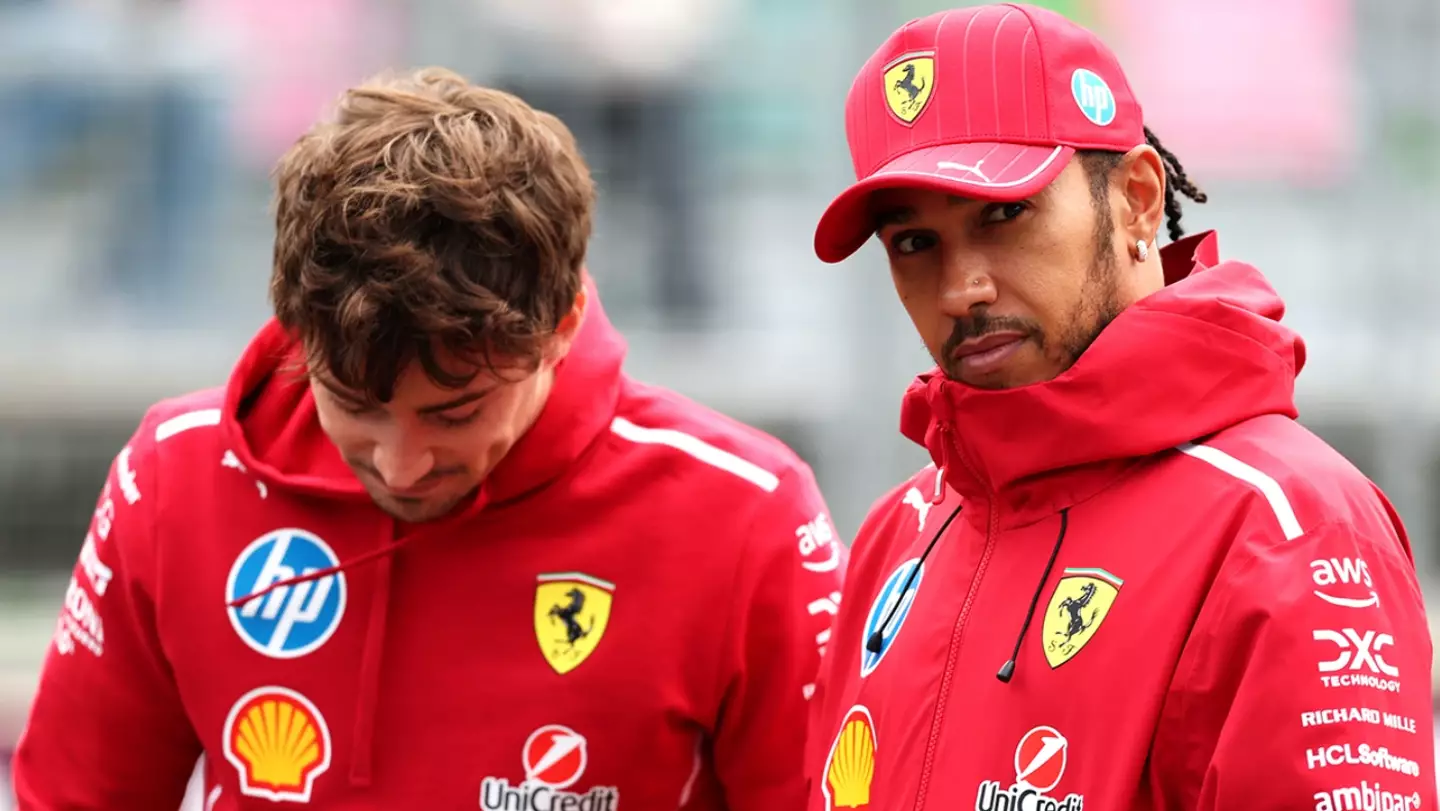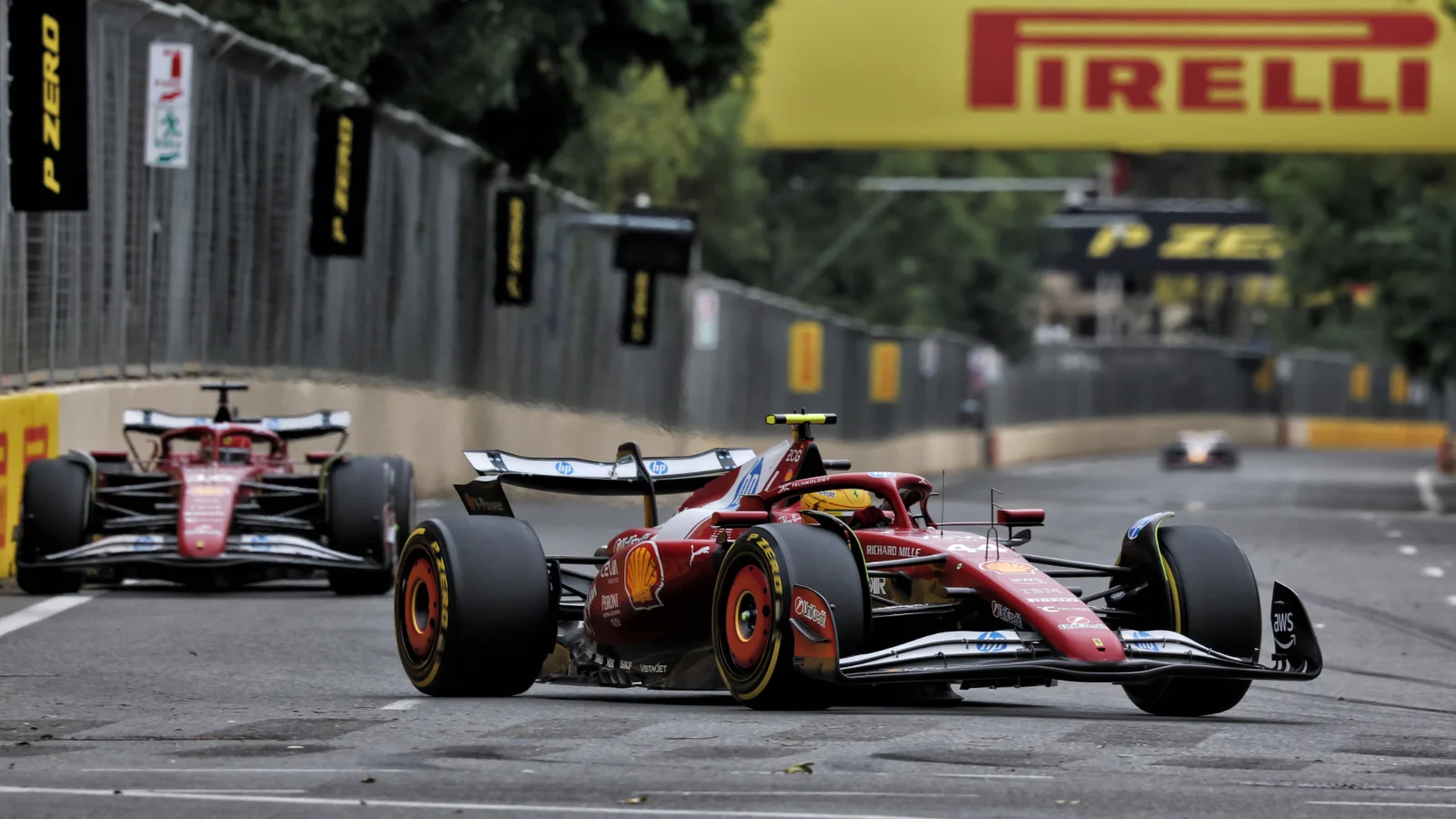The Azerbaijan Grand Prix in Baku, a street circuit synonymous with high drama and unpredictable outcomes, delivered its biggest shock not through a crash or a sensational overtake, but via a simple team radio message—and its deliberate rejection.
In the final, tense moments of the race, the radio inside Lewis Hamilton’s SF25 crackled to life. The instruction from his race engineer, Ricardo Adami, was direct, clear, and uncompromising: “Let Charles go from behind. He is one and a half behind you. This is the last round.” The seven-time world champion was ordered to yield his eighth position to his teammate, Charles Leclerc, who was running ninth.
What followed sent immediate shockwaves through the Ferrari garage and ignited a controversy that continues to burn fiercely across the world of Formula 1. Hamilton didn’t lift. He didn’t move aside. Instead, his car pulled away from Leclerc’s, maintaining P8 and consigning his teammate to P9. To the casual observer and many commentators, it looked like textbook insubordination: a superstar driver showing utter contempt for the pit wall. The image—Hamilton accelerating down the main straight, mere meters separating the two scarlet cars—seemed to be damning evidence of pure, self-serving defiance.
However, the real narrative unfolding in those crucial seconds is far more complex than a simple clash of egos. This was not just a fight for eighth place; it was a high-stakes tactical survival play that, according to leading F1 voices, exposed a deep, structural vulnerability within Ferrari—a vulnerability that threatens to derail their entire championship campaign.

The Unexpected Defence: Rosberg Reveals the ‘Survival Play’
To understand the truth behind Hamilton’s actions, we must turn to perhaps the most unlikely defender: Nico Rosberg. The 2016 World Champion, who shared one of the most intense and volatile rivalries in F1 history with Hamilton during their Mercedes days, offered a profoundly different perspective on what truly transpired in Baku.
According to Rosberg’s sharp analysis, what looked like an act of rebellion was, in fact, a necessary ‘survival play’—a split-second decision that prevented Ferrari from suffering a devastating double loss of position.
The tactical reality facing Hamilton in the final moments was perilous. They were fighting for eighth and ninth, but lurking just two seconds behind was Isack Hadjar of the Racing Bull team. Hadjar had expertly managed his tires, and crucially, was posting his fastest pace of the entire weekend. The margin for error for the two Ferraris was virtually non-existent.
Rosberg dissected the precarious situation: with the DRS enabled, fresh tires on Hadjar’s car, and the unforgiving nature of the high-speed Baku street circuit, any attempt by Hamilton to slow down and execute a position swap would have created a catastrophic disruption. Hadjar was perfectly positioned to capitalise on any brake light flash or moment of hesitation, potentially snatching both the eighth and ninth positions in a single, devastating move. Hamilton’s refusal was a direct, albeit brutal, counter-strategy designed to maintain the formation and salvage at least one point for the team.

The ‘Catastrophically Poor’ Order: Unmasking Ferrari’s Chaos
Rosberg’s conclusion was scathing, yet precise: the timing of Ferrari’s order was, in his words, “catastrophically poor.”
To ask a driver to execute a high-speed, last-lap position swap on the main straight, with compromised tires after 50-plus laps of punishment, and a wolf snapping at their heels, was equivalent to deploying a tactical blunder under maximum pressure.
This analysis moves the focus away from Hamilton’s alleged defiance and places it squarely on the systemic failures within the Ferrari strategy department. The Baku incident exposed an operational fragility that goes far beyond a simple miscommunication between a driver and his engineer. It forces a disturbing barrage of questions:
Why was no clear position-swap plan established ten laps earlier, when conditions were safer? Why did Ferrari’s strategists fail to adequately account for Hadjar’s aggressive pace and tire advantage? Why was such a critical, high-risk decision left to the chaos and split-second judgement of the final corner?
These questions remain officially unanswered, but they highlight a worrying pattern of improvised decision-making—a trait utterly incompatible with championship-winning ambitions. As Rosberg often emphasizes, Formula 1 titles are not won by the fastest car; they are won by the team that makes the fewest mistakes. And in Baku, Ferrari yet again demonstrated they are far from meeting that standard, preferring chaos management over clinical execution.
The Clash of Cultures: Hamilton’s Transforming Agenda
There is yet another layer to this saga that makes it a defining moment for the Scuderia. Lewis Hamilton’s arrival at Ferrari was never just about adding a fast driver. It was about importing a winning mentality—a specific culture of high-pressure execution honed during his years at Mercedes.
His decision in Baku, aside from its tactical justification, serves as a powerful message and a clear precedent. He is signalling that he will not blindly follow orders that compromise both his own competitive interests and the ultimate performance outcome for the team.
This sets up a fundamental clash of philosophies within the Maranello structure:
Charles Leclerc:
-
- Represents the traditional
Scuderia
-
- framework—respect the team hierarchy, trust the pit wall, and accept decisions even when frustrated. His immediate, emotional outburst—”This is stupid. It’s unfair,” followed by the biting sarcasm,
“You can enjoy that P8,”
-
- —revealed the depth of his commitment to the internal protocol and his subsequent fury at its violation.
Lewis Hamilton:
-
- Represents the modern, Mercedes-style winning culture, where drivers are empowered to
influence strategy, challenge decisions, and seize control
- when the pit wall appears strategically compromised.
The true battle at Ferrari is just beginning. According to insider observations, Hamilton’s influence extends beyond race day. He understands that winning requires political and strategic influence within the team structure. His defiance in Baku was a clear, calculated message directed not only to Adami but also to Leclerc and the top management: critical, ill-timed decisions will not be followed blindly, especially when they risk team performance.

The Uncomfortable Truth: Adapt or Collapse
The dynamic established by this incident creates a fascinating and potentially volatile scenario for the remainder of the season. Can Ferrari, an organization steeped in tradition and a hierarchical structure, adapt to Hamilton’s more assertive, challenge-oriented approach? Or will they repeat the cycles of internal collapse seen with previous champion drivers like Sebastian Vettel and Fernando Alonso, who ultimately left feeling frustrated by the operational environment?
The evidence suggests Ferrari faces a stark choice. They must either:
Embrace the uncomfortable reality
-
- of having two strong-willed, high-performing leaders who demand excellence and strategic coherence.
Risk losing yet another championship opportunity
- to internal dysfunction, strategic improvisation, and the inability to manage elite talent under the relentless pressure of the title fight.
The Baku incident was not merely Hamilton disobeying a team order. It was Ferrari being strategically exposed on a world stage. Their failures in communication, their strategic improvisation, and their fundamental inability to manage two elite drivers in high-pressure situations all became visible in those crucial final moments.
With Lewis Hamilton now making it undeniably clear that he has not arrived simply to integrate into the existing structures but rather to transform them, Ferrari’s championship aspirations depend entirely on their willingness to shed their historical flaws. What we witnessed in Azerbaijan may well define not just this season, but the entire future direction of the most iconic team in Formula 1. The question now is whether they will learn from this painful exposure or continue repeating the organizational mistakes that have cost them titles for over a decade.